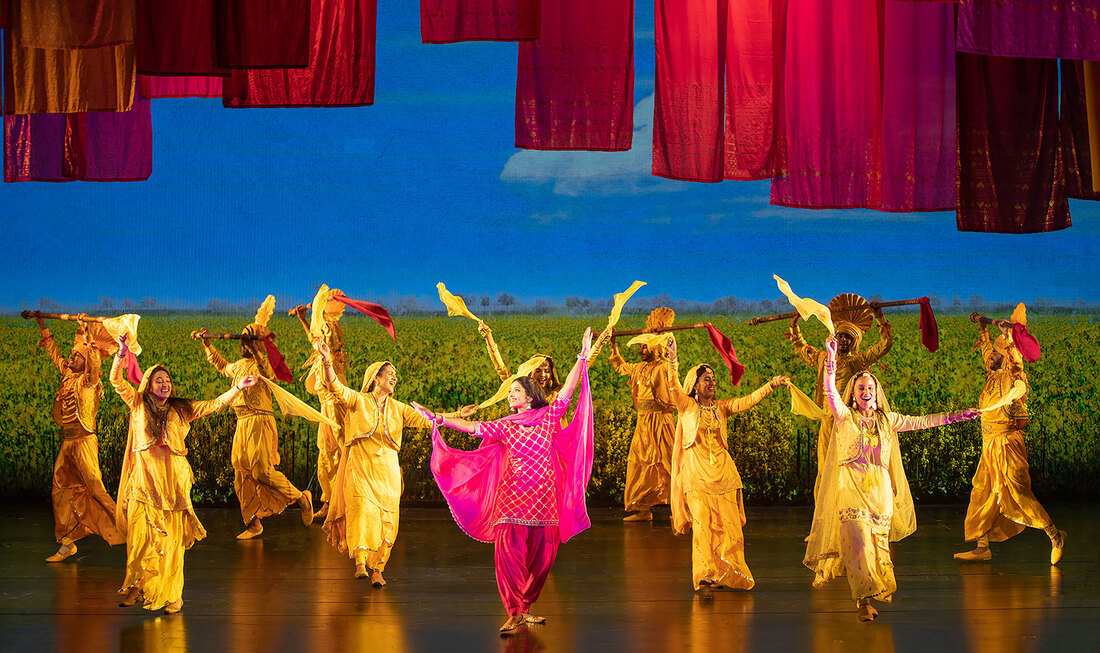|
The look of Bollywood is very much a part of "Come Fall in Love." Photo by Jim Cox For the record, I’ve never seen “Dilwale Dulhania Le Jayenge,” better known as “DDLJ,” the 1995 romantic Bollywood film on which the Old Globe’s world premiere musical, “Come Fall in Love,” is based. So I’m not going to make any comparisons, as ardent fans of the movie might, between it and this lavish production onstage in Balboa Park. Nor will I make a point of opining on the issue, articulated in detail recently in a New York Times article, of the musical adaptation’s reinventing the love story between two NRI’s (non-resident Indians living outside of their native country) as one between NRI Simran and a spoiled Harvard frat boy, Rog.
Instead, I’ll consider “Come Fall in Love” on face value. It’s a light-as-air (in spite of what it may be endeavoring to say about feminism and Indian identity) musical romance with prodigious sets (scenic design by Derek McLane), gorgeous costumes (by Linda Cho) and choreography of Indian dances by Shruti Merchant that evoke in sight and sound the richness of Bollywood filmmaking. The story ... I’m not especially in love with. The serious and bookish Simran (Shoba Narayan), a student at Harvard, encounters wealthy part-ay boy Rog (Austin Colby) at, what else? A part-ay, and she ends up being falsely arrested for something ridiculous having to do with flamingos. They meet again on Simran’s trip to Europe with her friends and predictably end up having to share a hotel room in Switzerland after missing a train. Nothing between them to this point suggested to me that they would fall for each other, and it’s a bit troubling that wallflower Simran’s over-consumption of complementary champagne is the first step toward her falling for Rog. He gallantly slept in the jacuzzi, not taking advantage of her. Good for Rog, but should that have been enough to turn Simran’s head? The long and short of it is by the time the Europe trip is over and Simran is bound for India to fulfill her arranged marriage there, she and Rog are pining for each other, their duet of denial, “Like You That Way.” being intentionally ironic. What happens in Act 2, the far superior of the two acts, in India comes as absolutely no surprise. This is, after all, a love story and a happy ending is preordained. Setting aside the story itself, “Come Fall in Love” enjoys some exemplary performances. As the lovers, Narayan and Colby are both pleasing vocalists and highly likable – that must not have been easy to achieve for Colby, whose first-act Rog is shudderingly vacuous, witnessed by the bacchanalian solo “Party and Spend Daddy’s Money.” Irving Iqbal as Baldev, Simran’s strict father, and Kate Loprest as Minky, Rog’s grown-sorority-girl mother, both deliver the kind of supporting performances that get awards. Iqbal’s opening number, “So Far,” for example, initiates “Come Fall in Love” with flourish and a degree of gravity, while Loprest’s presence throughout Act 2 is funny, sexy and sassy. The most touching moment in the show finds Rupal Pujara as Simran’s mother, Lajjo, comforting her daughter-at-a-crossroads in “I Give You the World.” “Come Fall in Love’s” score by Vishal Dadlani and Sheykhar Ravjiani is bold and sometimes bodacious, heard to best effect in pieces featuring Rog, the character who most evolves in this tale. Nell Benjamin’s lyrics are in that same spirit. Have to say, though, the fall in la-la-la-love refrain of the title song can only be called cutesie. Aditya Chopra, who directed “DDLJ,” directs “Come Fall In Love” as well and obviously understands the audience-pleasing dynamics that made the film such an enduring one and could be transferred to the stage. It’s counterintuitive to say that a two-hour, 45-minute production moves crisply because it really doesn’t, but there aren’t any draggy spots in “Come Fall in Love.” A couple of expendable songs? Maybe so. “Come Fall in Love” isn’t precisely Bollywood onstage, but it possesses enough of Indian cinema’s vibrancy and energy to satisfy those devoted to it. “Come Fall in Love” runs through Oct. 16 at the Old Globe Theatre in Balboa Park.
0 Comments
Leave a Reply. |
AuthorDavid L. Coddon is a Southern California theater critic. Archives
July 2024
Categories |
David Coddon |
|
